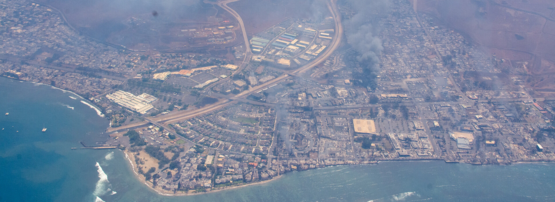
The Maui wildfires have caused immense damage to the historic town of Lāhainā. With as much as 75% of the town now destroyed, thousands of people have been displaced and the death toll continues to mount.
Alongside the primary needs of shelter, clean water, food, and medical assistance, communications are also a top priority. People need to check on loved ones, friends, and neighbours but also need to communicate with state and federal government agencies and other services.
With those communication needs in mind, what will it take for them to return after a disaster like this?
The first thing to understand is the magnitude of the problem. Hawaii is a volcanic chain of islands, Maui being one of the larger ones, but it is isolated. Maui is 5,800 km from the US mainland, and no closer to Japan, Australia, or New Zealand. Whatever is not held as a spare inside the Hawaiian Islands, or cannot be repurposed from them, must come a long way. So, bringing in technology of any kind becomes about how quickly flights or ships can arrive with the necessary cargo.
Telecommunications equipment like routers and switches for a local community are neither cheap nor small. Neither are the reels of fibre and cable required to connect houses in a town, poles, pit liners and pipes, or satellite dishes. There’s a likelihood that ‘spares’ for these things are simply not available in sufficient numbers for a catastrophe like this.
Modern telecommunications has two forms: Wired (copper or glass fibre wires) and wireless (terrestrial microwave, Wi-Fi or other radio frequency, or via satellites in low, medium, or geosynchronous orbit). Both wired and wireless depend critically on local infrastructure. These services demand power, air conditioning, and in the case of wired telecommunications either buried or strung cables.
Fires like those on Maui are all-consuming. They generate sufficient heat for long enough to melt steel and destroy buildings. Therefore, the basic building blocks of communication both in the ground and above ground on poles have been completely destroyed — not damaged or pulled down — melted and vaporized. The poles are ash, and the endpoint buildings that house provide routing and switching gear and supply power down the line are destroyed.
Restoring communications to the affected areas could be considered a ‘greenfield’ deployment as nothing of use remains, but it’s worse. The affected areas are really ‘brownfield’ with contamination risks including asbestos, which was commonly used in semi-industrial buildings like telephone exchanges as insulation, and massive amounts of plastic used to wrap wires and fibres, leaving fire pollution behind.
Wireless communications are not free of this dependency on existing infrastructure either. Radio masts, microwave antennae, and satellite dishes are just as combustible as the telephone exchange and Internet hubs. This equipment has in many cases been destroyed. It is unlikely that any significant infrastructure can be repurposed.
So, both common options for digital communications share similar problems compounded by how quickly new equipment, cables, critical power, and air conditioning can be sent to Maui and deployed while competing for aircraft or boat space, and human resources to load, unload, and deploy with all the other critical service needs. International communication supplies must compete with the supply of medical and power equipment, water, food, temporary shelter, and more basic needs. Everything people need must be brought into the same place. Why should digital communications come first?
One reason is that, after the basic needs of health and housing and food are taken care of, accessing modern ‘help’ in the widest possible sense really depends on being online. Compare an online service to a paper form system for example. Supplying paper copies for every state and federal agency to all the residents of Lāhainā seeking assistance would be another large burden but, if access to Wi-Fi, Zoom calls, and phone recharging is provided, the same people can bootstrap their own access into services. For an economy the size of the USA, 15,000 simultaneous applications would be a drop in the ocean of normal service delivery.
So, getting the Internet back online is arguably one of the urgent services needing restoration. It could even reduce burdens on other more urgent service delivery.
Internet engineers in Hawaii are responding to the crisis. The NANOG mailing list has a good thread detailing the consequences of the fire, and the reaction from the local engineers. Work is ongoing to deliver temporary services, and local engineers have welcomed access to Starlink Satellite communications, which (at the cost of needing local power) claim to support hundreds of people using essential mobile services.
As the NANOG discussion shows, historical investment in telecommunications in Lāhainā has shaped the present-day infrastructure. A former Bell telco investment in central service delivery for the town has been integrated into successive waves of investment by new service providers. Due to the economics of telecommunications deployment, and like many other isolated island communities, Lāhainā largely depended on that one asset.
In light of the Maui wildfires and other remote community disasters, it’s apparent that the global communications sector should focus on creating more resilient networks, reducing vulnerabilities, and establishing efficient recovery strategies in the face of potential future disasters.
The Hawaiian community has a web page for people interested in helping with donations, which includes internationally visible bodies like the Red Cross.
The views expressed by the authors of this blog are their own and do not necessarily reflect the views of APNIC. Please note a Code of Conduct applies to this blog.
